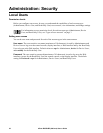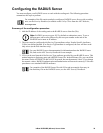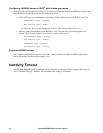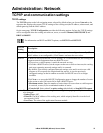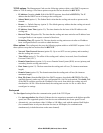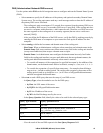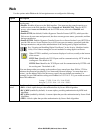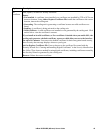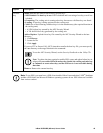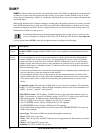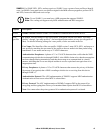InRow RC/RD/RP (600 mm) User’s Guide40
TCP/IP options. The Management Card uses the following options within a valid DHCP response to
define its TCP/IP settings. All of these options except the first are described in RFC2132.
• IP Address (from the yiaddr field of the DHCP response, described in RFC2131): The IP
address that the DHCP server is leasing to the cooling unit.
• Subnet Mask (option 1): The Subnet Mask value that the cooling unit needs to operate on the
network.
• Router, i.e., Default Gateway (option 3): The default gateway address that the cooling unit needs
to operate on the network.
• IP Address Lease Time (option 51): The time duration for the lease of the IP Address to the
cooling unit.
• Renewal Time, T1 (option 58): The time that the cooling unit must wait after an IP address lease
is assigned before it can request a renewal of that lease.
• Rebinding Time, T2 (option 59): The time that the cooling unit must wait after an IP address
lease is assigned before it can seek to rebind that lease.
Other options. The cooling unit also uses the following options within a valid DHCP response. All of
these options except the last are described in RFC2132.
• Network Time Protocol Servers (option 42): Up to two NTP servers (primary and secondary)
that the cooling unit can use.
• Time Offset (option 2): The offset of the cooling unit's subnet, in seconds, from Coordinated
Universal Time (UTC).
• Domain Name Server (option 6): Up to two Domain Name System (DNS) servers (primary and
secondary) that the cooling unit can use.
• Host Name (option 12): The host name that the cooling unit will use (32-character maximum
length).
• Domain Name (option 15): The domain name that the cooling unit will use (64-character
maximum length).
• Boot File Name (from the file field of the DHCP response, described in RFC2131): The fully
qualified directory-path to an APC user configuration file (.ini file) to download. The siaddr field
of the DHCP response specifies the IP address of the server from which the cooling unit will
download the .ini file. After the download, the cooling unit uses the .ini file as a boot file to
reconfigure its settings.
Port speed
The Port Speed setting defines the communication speed of the TCP/IP port.
• For Auto-negotiation (the default), Ethernet devices negotiate to transmit at the highest possible
speed, but if the supported speeds of two devices are unmatched, the slower speed is used.
• Alternatively, you can choose either 10 Mbps or 100 Mbps, each with the option of half-duplex
(for communication in only one direction at a time) or full-duplex (for communication
simultaneously in both directions on the same channel).



